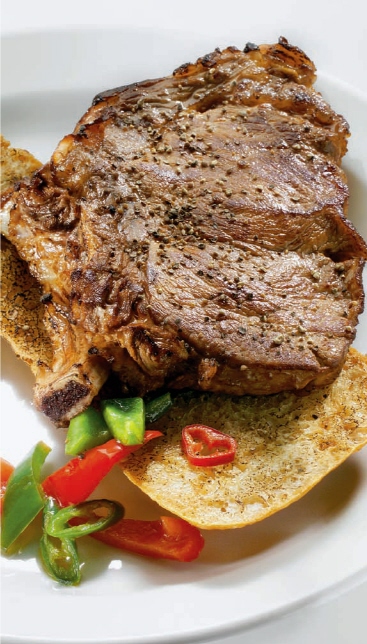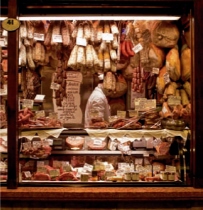
BISTECCA ALLA FIORENTINA
FLORENTINE STEAK
These massive steaks are traditionally cooked over the hot coals from a red or evergreen oak. For us, this meant chopping up and then setting fire to Phillip’s antique writing desk, but you might be able to find a more convenient source.

HOT COALS, IDEALLY HARDWOOD
THICK CHIANINA STEAKS,* BONE IN
SALT
*Chianina are a breed of cattle that grow to a massive size as a result of careful breeding, although steroids are now often used by less scrupulous farmers. Be wary of any steak requiring more than two people to lift it.
1. Make sure your coals are hot and that the grill is well heated.
2. Place the steaks on the grill and sear them briefly to seal.
3. Reduce the heat by raising the grill a little. After a few minutes, turn the meat and salt the freshly grilled surface generously.
4. After another few minutes, turn the steaks again and salt. The important thing to note is that following the initial searing on a very high heat, the heat must remain constant and intense. If the coals even look like they’re dying down, gently fan them back to life.
5. When done, the steak should still be rare on the inside.
AUDREY’S TIP
This amazing dish is often accompanied by a simple salad of chicory and bitter radicchio leaves, which many locals believe aids digestion. Mind you, Tuscans are also convinced that fennel can prevent HIV, so one should be a little wary of relying too heavily on medical folklore.
8 August
Our culinary voyage of discovery continued this morning, as Phillip and I headed for the town of Montecchi for lunch at a restaurant called Carduno that had been highly recommended by friends. We’re both adventurous eaters; however, there are some things we draw the line at. Today’s menu offered stracotto d’asino (or donkey stew), a dish common in this region. Having grown up with these gentle, trusting animals, and even ridden them along the beachfront as a child, there was no way we could face seeing one on a plate so I settled instead for a simple dish of veal, while Phillip had sfilacci (shredded horsemeat) and a salad.

It doesn’t take one long to realise that Tuscans will eat just about anything! Buristo (pig’s blood salami), soprassata (cow’s head, skin and tongue), picchiante (cow’s lungs) and cibreo (chicken’s heart, liver and cockscomb) all find their way onto the table. Yet, curiously, most people will draw the line at decaffeinated coffee.